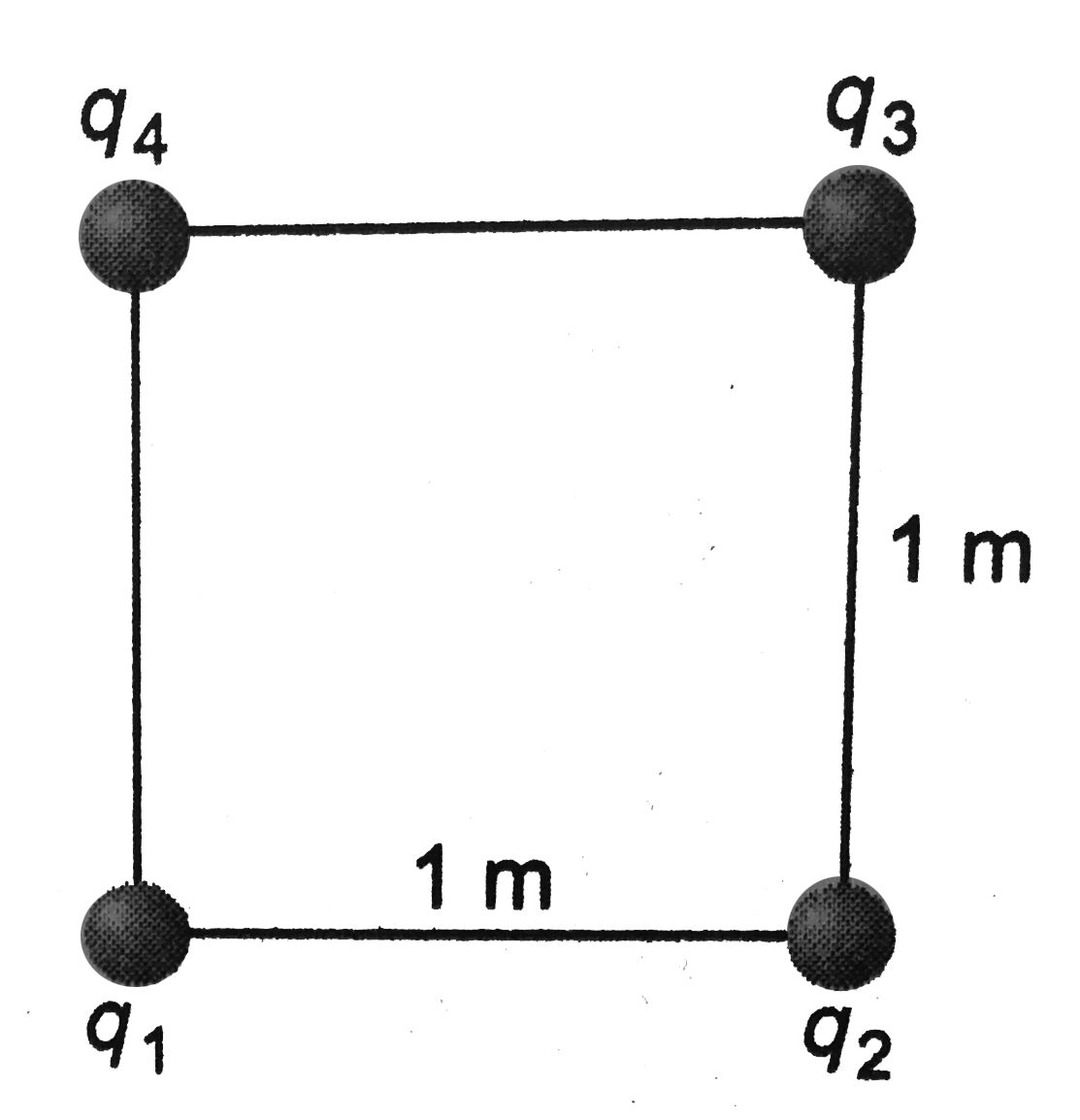Four charges +3μC,−1μC,+5μCand−7μC are arranged on the circumference of a circle of radius 0.5m. The potential at the centre is
zero
18×104V
−18×104V
18×10−4V
The correct Answer is:A
To find the electric potential at the center of a circle where four charges are arranged on its circumference, we can follow these steps:
1. Identify the Charges and Their Values:
We have four charges:
- Charge 1: +3μC=+3×10−6C
- Charge 2: −1μC=−1×10−6C
- Charge 3: +5μC=+5×10−6C
- Charge 4: −7μC=−7×10−6C
2. Determine the Radius of the Circle:
The radius of the circle is given as r=0.5m.
3. Formula for Electric Potential:
The electric potential V due to a point charge Q at a distance r is given by:
V=kQr
where k is Coulomb's constant, approximately 8.99×109Nm2/C2.
4. Calculate the Potential at the Center Due to Each Charge:
Since all charges are at the same distance r from the center, we can calculate the potential due to each charge and then sum them up.
- Potential due to Charge 1:
V1=k⋅3×10−60.5
- Potential due to Charge 2:
V2=k⋅(−1)×10−60.5
- Potential due to Charge 3:
V3=k⋅5×10−60.5
- Potential due to Charge 4:
V4=k⋅(−7)×10−60.5
5. Sum the Potentials:
The total potential at the center V is the sum of the potentials due to all four charges:
V=V1+V2+V3+V4
Substituting the values:
V=k⋅3×10−60.5+k⋅(−1)×10−60.5+k⋅5×10−60.5+k⋅(−7)×10−60.5
6. Combine the Charges:
Combine the coefficients of k:
V=k(3−1+5−70.5×10−6)
Simplifying the expression inside the parentheses:
3−1+5−7=0
Thus:
V=k⋅0=0
Final Result:
The potential at the center of the circle is V=0V.
We have four charges:
- Charge 1: +3μC=+3×10−6C
- Charge 2: −1μC=−1×10−6C
- Charge 3: +5μC=+5×10−6C
- Charge 4: −7μC=−7×10−6C
The radius of the circle is given as r=0.5m.
The electric potential V due to a point charge Q at a distance r is given by:
V=kQr
where k is Coulomb's constant, approximately 8.99×109Nm2/C2.
Since all charges are at the same distance r from the center, we can calculate the potential due to each charge and then sum them up.
V1=k⋅3×10−60.5
- Potential due to Charge 2:
V2=k⋅(−1)×10−60.5
- Potential due to Charge 3:
V3=k⋅5×10−60.5
- Potential due to Charge 4:
V4=k⋅(−7)×10−60.5
The total potential at the center V is the sum of the potentials due to all four charges:
V=V1+V2+V3+V4
Substituting the values:
V=k⋅3×10−60.5+k⋅(−1)×10−60.5+k⋅5×10−60.5+k⋅(−7)×10−60.5
Combine the coefficients of k:
V=k(3−1+5−70.5×10−6)
Simplifying the expression inside the parentheses:
3−1+5−7=0
Thus:
V=k⋅0=0
The potential at the center of the circle is V=0V.
Topper's Solved these Questions
- ELECTROSTATIC POTENTIAL AND CAPACITANCEBook:NARAYNAChapter:ELECTROSTATIC POTENTIAL AND CAPACITANCEExercise:Exercise-2(C.W)
Explore 53 Videos
- ELECTROSTATIC POTENTIAL AND CAPACITANCEBook:NARAYNAChapter:ELECTROSTATIC POTENTIAL AND CAPACITANCEExercise:EXERCISE -2 (H.W)
Explore 50 Videos
- ELECTROSTATIC POTENTIAL AND CAPACITANCEBook:NARAYNAChapter:ELECTROSTATIC POTENTIAL AND CAPACITANCEExercise:Exercise -1 (C.W)
Explore 44 Videos
- ELECTROMAGNETIC WAVES Book:NARAYNAChapter:ELECTROMAGNETIC WAVES Exercise:EXERCISE -4
Explore 15 Videos
- ELECTROSTATICS AND GAUSS LAWBook:NARAYNAChapter:ELECTROSTATICS AND GAUSS LAWExercise:Intergers type question
Explore 11 Videos
Similar Questions
Four point charges of +1μc each are placed on the four corners of a square of side 1 m. Calculate the electric potential at the centre of the square.
View SolutionFour point charges +1μC,+1μC,−1μCand−1μC are placed at the corners A,B,C and D of a square of each side 0.1 m (i) Calculate electric potential at the center O of the square (ii) If E is middle point of BC, what is work done in carrying an electron from O to E ?
View Solution
Knowledge Check
Electric charges of +10μC,+5μC,−3μCand+8μC are placed at the corners of a square of side √2 m, the potential at the centre of the square is
A1.8 VB1.8×106VC1.8×105VD1.8×104VFour charges of 6μC,2μC,−12μCand4μC are placed at the corners of a square of side 1m. The square is in x-y plane and its centre is at origin. Electric potential due to these charges is zero everywhere or the line
Ax=y,z=0Bz=0=zCx=0=yDx=z,y=0Three charges 4μC,4μCand−4μC are placed at vertices of an equilateral triangle of side length 20cm. The potential centre is nearly.
A3.1×103VB3.1×104VC3.1×105VD3.1×106V
A charge of 500 μC is distributed uniformly over the circumference of a ring of radius 25 cm. What will be be electric potential at the centre of ring?
View SolutionFour particles with charges 9μC,10μC,15μCand20μC are placed at the corners of a square with side 10 cm as shown in the figure. Calculate the work done by an external agent in assembling the charges at their locations.
View SolutionFour charges q1=1μC,q2=2μC,q3=−3μC and q4=4μC are kept on the vertices of a square of side 1m. Find the electric potential energy of this system of charges.

View SolutionA unit positive charge is moved along the circumfer-ence of a circle of radius, r with a −5μC charge at the centre at the centre of the circle. Then, the work done in the process is ______.
View SolutionFour charges qA=2μC,qB=−5μC,qc=2μC and qD=−5μC are placed at comers of a square ABCD of side 10 cm. What is the force on a charge of 1μC placed at centre of the square?
View Solution

